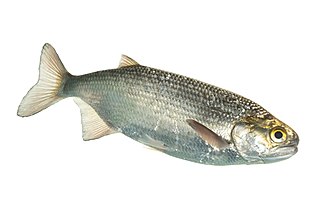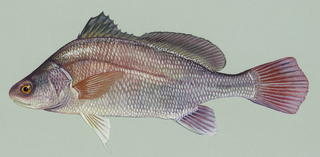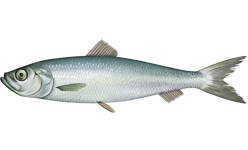
Herring are various species of forage fish, belonging to the order Clupeiformes.

Sardine and pilchard are common names for various species of small, oily forage fish in the herring suborder Clupeoidei. The term 'sardine' was first used in English during the early 15th century; a somewhat dubious etymology says it comes from the Italian island of Sardinia, around which sardines were once supposedly abundant.

The black crappie is a freshwater fish in the sunfish family (Centrarchidae). It is endemic to North America, one of the two types of crappies. It is very similar to the white crappie in size, shape, and habits, except that it is darker, with a pattern of black spots. Alternate names for the species include calico bass, speck, speckled perch, speckled bass, moonfish, grass bass, strawberry bass, shiner, crawpie, oswego bass, sac-a-lait, and marigane noire.

The ilish, also known as the ilishi, hilsa, hilsa herring or hilsa shad, is a species of fish related to the herring, in the family Clupeidae. It is a very popular and sought-after food in the Bengal region, and is the national fish of Bangladesh and state fish of the Indian state of West Bengal.

The goldeye is a freshwater fish found in Canada and the northern United States. It is one of only two extant species in the family Hiodontidae, the other species being Hiodon tergisus. The species name alosoides means shad-like. It is also called Winnipeg goldeye, western goldeye, yellow herring, toothed herring, shad mooneye, la Queche, weepicheesis, or laquaiche aux yeux d’or in French.

The freshwater drum, Aplodinotus grunniens, is a fish endemic to North and Central America. It is the only species in the genus Aplodinotus, and is a member of the family Sciaenidae. It is the only North American member of the group that inhabits freshwater for its entire life. Its generic name, Aplodinotus, comes from Greek meaning "single back", and the specific epithet, grunniens, comes from a Latin word meaning "grunting". It is given to it because of the grunting noise that mature males make. This noise comes from a special set of muscles within the body cavity that vibrate against the swim bladder. The purpose of the grunting is unknown, but due to it being present in only mature males and during the spawning season, it is assumed to be linked to spawning.
Hilsa is a common name for Tenualosa ilisha a fish found in Bangladesh and India.

The skipjack herring is a North American, migratory, fresh- and brackish water fish species in the herring family Alosidae. The name skipjack shad comes from the fact that it is commonly seen leaping out of the water while feeding. Other common names include blue herring, golden shad, river shad, Tennessee tarpon, and McKinley shad. The skipjack shad is restricted to the Gulf of Mexico drainage basins. Skipjack are found in clear to moderately turbid water in areas with flow. Because they are a migratory species, dams often impede their reproduction. Records suggest that this species was much more abundant in the Upper Mississippi River basin before it was impounded. Currently, skipjack is most abundant in the Upper Mississippi River below the mouth of the Ohio River. They are known as an "early-run" species as they migrate to spawn in the early spring.

The allis shad is a widespread Northeast Atlantic species of fish in the Alosidae family. It is an anadromous fish which migrates into fresh water to spawn. It is found in the eastern Atlantic Ocean, the western Baltic Sea and the western Mediterranean Sea. In appearance it resembles an Atlantic herring but has a distinctive dark spot behind the gill cover and sometimes a row of up to six spots behind this. It sometimes hybridises with the twait shad. This fish becomes mature when three or more years old and migrates to estuaries, later swimming up rivers to spawn. Populations of this fish have declined due to overfishing, pollution and habitat destruction. Conservation of this species is covered by Appendix III of the Bern Convention and Appendix II and V of the European Community Habitats Directive.

The twait shad or twaite shad is a species of fish in the family Alosidae. It is found in the eastern Atlantic Ocean and the Mediterranean Sea and is an anadromous fish which lives in the sea but migrates into fresh water to spawn. In appearance it resembles an Atlantic herring but has a row of six to ten distinctive spots on its silvery flanks. They become mature when three or more years old and migrate to estuaries, later swimming up rivers to spawn. Populations of this fish have declined due to overfishing, pollution and habitat destruction. Conservation of this species is covered by Appendix III of the Bern Convention and Appendix II and V of the European Community Habitats Directive.
Alosa vistonica the Thracian shad, is an extinct species of shad, a freshwater fish in the family Alosidae. It was endemic to a single shallow lake, Lake Vistonida in Greece. It was officially declared extinct by the International Union for Conservation of Nature in October 2024 as the species has not been recorded within its only known distribution since 1995.

Tenualosa is a genus of ray-finned fish belonging to the family Dorosomatidae, which also includes the gizzard shads and sardinellas. These fishes are found in rivers, brackish waters and coasts in the Indo-Pacific region.

Myxocyprinus is a monotypic genus of freshwater fish in the monotypic subfamily Myxocyprininae within the family Catostomidae. The only species is Myxocyprinus asiaticus, also known as the Chinese sucker.

The toli shad or Chinese herring is a fish of the family Clupeidae, a species of shad distributed in the western Indian Ocean and the Bay of Bengal to the Java Sea and the South China Sea. It may be found in Mauritius and the Cambodian Mekong near the Vietnam border. It inhabits fast-flowing, turbid estuaries and adjacent coastal waters.
The Caspian lamprey, Caspiomyzon wagneri, is a species of lamprey native to the Caspian Sea, and a member of the Petromyzontidae family. This species is a non-parasitic lamprey that feeds on animal carcasses.

The leaping bonito is a species of saltwater finfish from the Scombridae (Mackerel) family. Scombridae includes such tribes as the mackerels, tunas, and bonitos – of the latter of which, the Sardini tribe, this fish is a member. It is the only member of the genus Cybiosarda, which is therefore called a monotypic taxon. Since the bonitos and tunas are close relatives, this fish has variously been referred to by such other common names as Australian tuna, striped bonito and Watson's bonito.

Ethmalosa fimbriata, the bonga shad or just bonga, is a shad-like ray-finned fish, belonging to the family Dorosomatidae, formerly considered to be in the family Clupeidae. This species occurs along the coasts and in brackish water of coastal lagoons, rivers and lakes of western Africa from Dakhla in Western Sahara to Lobito in Angola. It is usually around 25 cm long but the maximum length is 45 cm. It is the only member of its genus.
Konosirus punctatus is a species of fish in the family Dorosomatidae. It is the only member of the monotypic genus Konosirus. Its common names include dotted gizzard shad and konoshiro gizzard shad. It is native to the northwestern Pacific Ocean, where it occurs along the Asian coastline.

Clupea is genus of planktivorous bony fish belonging to the family Clupeidae, commonly known as herrings. They are found in the shallow, temperate waters of the North Pacific and the North Atlantic oceans, including the Baltic Sea. Two main species of Clupea are currently recognized: the Atlantic herring and the Pacific herring, which have each been divided into subspecies. Herrings are forage fish moving in vast schools, coming in spring to the shores of Europe and America, where they form important commercial fisheries.

The Alabama shad is an anadromous species of alosid fish endemic to the United States where it breeds in medium to large flowing rivers from the Mississippi River drainage to the Suwannee River, Florida, as well as some other Gulf coast drainages. The biology of this fish is little known but it has become increasingly rare. The International Union for Conservation of Nature rated it "near threatened" in 2020 and the United States National Marine Fisheries Service has listed it as a Species of Concern. A principal reason for its decline is thought to be the many locks and dams blocking access for the fish to up-river spawning grounds.

















